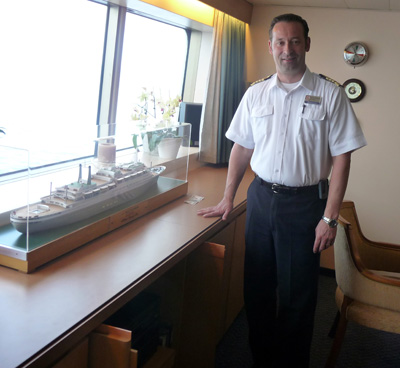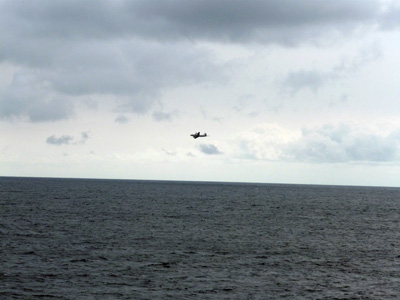 Lifeboat maneuvers to floating object in Pacific during
Lifeboat maneuvers to floating object in Pacific during
recovery operation. Photos: Donald H. Harrison
___________________________________________________
By Donald H. Harrison
-Second in a series–
 ABOARD MS ROTTERDAM –Recovering the body of a man who threw himself overboard and avoiding a possible tsunami in the wake of a large Chilean earthquake were unscheduled and unforgettable events during a recent cruise aboard the Holland America cruise ship Rotterdam.
ABOARD MS ROTTERDAM –Recovering the body of a man who threw himself overboard and avoiding a possible tsunami in the wake of a large Chilean earthquake were unscheduled and unforgettable events during a recent cruise aboard the Holland America cruise ship Rotterdam.
Passenger Walter A____ apparently climbed to a railing near the fantail on the Lower Promenade Deck of the Rotterdam and, according to a witness, cast himself into the sea off the coast of Colombia close to noontime Friday, Feb. 26, as other passengers, including his wife Judy, were having their lunch.
The witness was another passenger who came horrified upon the suicide as it was occurring. She immediately reported the event to a deck officer, who in turn relayed the information to the bridge crew, and they in turn notified the master of the vessel, Captain Rik Krombeen. Within six minutes of the occurrence, Kronbeen ordered the ship to turn around and to begin a search for the victim, he later told this reporter. My wife Nancy and I were also among the 1,330 passengers aboard the 780 foot- long, 59,885-gross ton ship.
 So that passengers would not become alarmed by the ship’s sudden change in direction on its sea day crossing the Equator between its ports of call at Manta, Ecuador, and Puerto Caldera, Costa Rica, the captain (shown at left) announced that a man was believed to have gone overboard. He asked the passengers to watch the waters for any sign of him. At various times as the ship ran a search pattern, he also asked for complete silence on deck in the event that the victim was yelling for help.
So that passengers would not become alarmed by the ship’s sudden change in direction on its sea day crossing the Equator between its ports of call at Manta, Ecuador, and Puerto Caldera, Costa Rica, the captain (shown at left) announced that a man was believed to have gone overboard. He asked the passengers to watch the waters for any sign of him. At various times as the ship ran a search pattern, he also asked for complete silence on deck in the event that the victim was yelling for help.
The wife, thinking her 72-year-old husband was trying to nap, brought lunch down to their first-deck cabin, but found that he was not there. She called the Front Office and informed the personnel there that her husband was unexpectedly missing. Cruise Director Joseph Pokorski made two announcements on the public address system asking Mr. A ____ to please call the Front Office. When Mr. A___ did not respond, it became understood throughout the ship that he was the man in question. Captain Korbeen and Holland America authorities asked that the man’s surname be withheld in this report.
After backtracking to the approximate location where Mr. A___ had gone into the water, the ship’s crew began dropping small buoys in order to determine which way the currents would take them and how quickly. Meanwhile, a search and rescue airplane, which Captain Korbeen said had been dispatched from Colombia at the request of the U.S. Coast Guard, flew over the area.
Given that the Pacific Ocean waters were calm and warm, it was estimated that a victim desiring to stay alive could do so for up to 36 hours in those seas. However, if as suspected, Mr. A___ had the intention of taking his life, the Coast Guard might choose to end the search far earlier. Whereas a victim who wants to stay alive will wave his arms and yell for help, an intended suicide typically will do nothing to assist his potential rescuers. Wearing gray and white clothes on an overcast day, Mr. A___ could not be seen from a distance greater than 70 yards away.
 Guided by the mathematics of time and currents, the cruise ship and rescue plane (shown at right) proceeded in ever narrowing circles. Approximately four hours after the incident occurred the airplane messaged that it needed to return to land to refuel. Accordingly, it had but one pass left, and Captain Kornbeen requested that it fly along a line paralleling the ship’s calculations of the man’s drift.
Guided by the mathematics of time and currents, the cruise ship and rescue plane (shown at right) proceeded in ever narrowing circles. Approximately four hours after the incident occurred the airplane messaged that it needed to return to land to refuel. Accordingly, it had but one pass left, and Captain Kornbeen requested that it fly along a line paralleling the ship’s calculations of the man’s drift.
The airplane spotted something in the water and reported the Global Positioning System location to the ship. Captain Korbeen announced to the passengers that he would be going quite quickly to that position and might need to make a sudden turn. He urged passengers to be prepared to balance themselves.
A lifeboat had been lowered to the Lower Promenade Deck to permit crewmembers easy access when it was time to retrieve the body. As the crew members clambered into the life boat, security officers directed passengers to move several cabin widths away. Once in the ocean, the lifeboat maneuvered in such a way as to screen from the passengers a view of Mr. A___’s body being lifted into the lifeboat. Passengers then were asked “out of respect” to clear the deck so that Mr. A___’s body could be brought aboard and moved to the small morgue aboard the Rotterdam. Five hours had elapsed since the original incident.While all this was occurring, on-board care teams stayed with Mrs. A____ and with the woman who had witnessed the suicide, offering both women comfort and counseling. Meanwhile, Holland America’s office in Seattle, Washington, got in touch with Jason, the son of Mr. and Mrs. A____, recounted to him what happened, and arranged for him and his wife to fly to Costa Rica to meet his mother and to help with the formalities for claiming and transporting Mr. A___’s remains back to the United States.
Mr. and Mrs. A____ had been active cruisers who had liked to post critics’ comments about various experiences at sea on line. A group of these cruisers were aboard the vessel, and a memorial service the following morning for Mr. A___ led by an onboard minister was arranged.
Holland America’s main office gave permission to Captain Korbeen to try to make up as much time as possible en route to Puerto Caldera, Costa Rica, meaning that instead of proceeding at 19 knots in the evening and overnight, the ship at times reached nearly 25 knots—burning fuel at the rate of more than $70 a minute. Originally scheduled to come in at 8 a.m., this procedure would have brought Rotterdam to its Costa Rican port at 9 a.m. However, news came of the great 8.8 magnitude earthquake in Concepcion, Chile, presenting Captain Korbeen with two new challenges – one nautical and one intensely personal.
There was a possibility that the Chilean earthquake would generate dangerous tides in the bay of Puerto Caldera, Costa Rica. The water might come into the bay and then just as quickly go out, leaving a ship entering the bay without sufficient water to proceed or pushing it in the wrong direction. In consultation with local authorities, Kornbeen decided to wait in ocean waters outside the port until it could be determined what the tidal effects were. As it turned out, the tidal effect was insignificant, and Rotterdam reached its berth at 9:32 a.m.
More pressing was a problem on board the ship. A young woman who worked in the gift shops was from Concepcion, Chile, and she was unable to reach anyone by telephone. For three days, she frantically tried to telephone home, but was unsuccessful. She later learned that her own apartment had been destroyed, and so had that of her brother. Luckily, her brother was staying with their parents during the earthquake—and the home of their parents had survived the earthquake. Although both the employee and the brother had lost their homes, the important matter was that all her family members were safe.
The young woman debated whether she should try to fly home immediately, but her family urged her to remain on board. Concepcion was in chaos, and there was little she could do at home. On the other hand, the money she was earning aboard Rotterdam would be of benefit to the family. When fellow crewmembers learned of what had befallen their shipmate, they took up a collection to help the family.
Sometime after Mr. A___’s body was taken off the ship, his son Jason posted a note on the Intenet site of the cruise critics expressing his gratitude and that of his family to Holland America for its compassion during a most difficult time. “My dad, Walter was the individual that went overboard on the 26th off the Rotterdam,” he wrote. “Dad was a very strong individual that lived life to its fullest. He had become progressively more ill and knew that there was little he could do to change it.” Of his mother, Judy, he wrote that the ships personnel “became her guardian angels. She would like to personally thank each and every crew member that assisted her in her time of need. Holland America went above and beyond the call of duty in taking care of both her and my wife and I.”
Jason said after flying to Costa Rica, he met with his mother and Care Team members who were “invaluable guides for us in Costa Rica as we underwent the long, arduous process of working our way through the government bureaucracy that stood between us and getting dad home. It took us five days and they were our ever present friends and guides. They were our moral and physical support. They helped us figure out how to get dad from the mortuary to the funeral home, how to get his body cremated, how to prepare the required embassy paperwork, arranged transportation, meals and lodging for the entire ordeal. They cried with us and laughed with us. They are our heroes.”
It was not only the family that was grateful to the cruise line. At a “Life at Sea” presentation in which passengers had the opportunity to question the captain, cruise director, hotel manager and chief engineer on a wide range of subjects including precautions against gastro-intestinal infections, elevators that weren’t working, on-board movie selection, and even the status of the karaoke machine, one man rose to say, “during the tragic event we had, I must compliment you captain and your crew the way you picked up that body.”
There was spontaneous sustained applause from the audience that filled the main floor and balcony of the show room.
*
Next in the series: Warding off the GIS virus
*
Harrison is editor of San Diego Jewish World